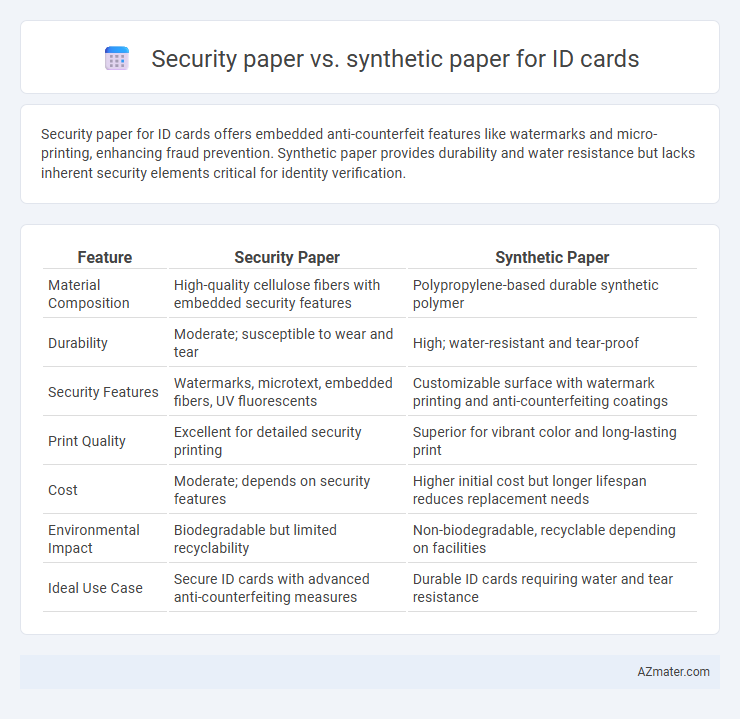Security paper for ID cards offers embedded anti-counterfeit features like watermarks and micro-printing, enhancing fraud prevention. Synthetic paper provides durability and water resistance but lacks inherent security elements critical for identity verification.
Table of Comparison
| Feature | Security Paper | Synthetic Paper |
|---|---|---|
| Material Composition | High-quality cellulose fibers with embedded security features | Polypropylene-based durable synthetic polymer |
| Durability | Moderate; susceptible to wear and tear | High; water-resistant and tear-proof |
| Security Features | Watermarks, microtext, embedded fibers, UV fluorescents | Customizable surface with watermark printing and anti-counterfeiting coatings |
| Print Quality | Excellent for detailed security printing | Superior for vibrant color and long-lasting print |
| Cost | Moderate; depends on security features | Higher initial cost but longer lifespan reduces replacement needs |
| Environmental Impact | Biodegradable but limited recyclability | Non-biodegradable, recyclable depending on facilities |
| Ideal Use Case | Secure ID cards with advanced anti-counterfeiting measures | Durable ID cards requiring water and tear resistance |
Introduction to ID Card Materials
Security paper for ID cards incorporates embedded security features such as watermarks, microtext, and UV-reactive elements to prevent counterfeiting and unauthorized duplication. Synthetic paper, made from durable plastic polymers like polypropylene, offers enhanced resistance to moisture, tearing, and wear, making it ideal for long-lasting identification cards. Both materials are selected based on required security levels and durability, with security paper emphasizing anti-fraud properties and synthetic paper prioritizing physical resilience.
What is Security Paper?
Security paper is specially engineered to prevent tampering, counterfeiting, and unauthorized duplication, making it ideal for official documents like ID cards. It incorporates advanced features such as watermarks, microprinting, embedded fibers, and holograms that enhance document integrity and verification. Compared to synthetic paper, security paper prioritizes embedded security elements over durability, ensuring authenticity and protection against fraud.
What is Synthetic Paper?
Synthetic paper is a durable, tear-resistant material made from plastic resins like polypropylene, ideal for printing secure and long-lasting ID cards. Unlike traditional security paper, synthetic paper offers water resistance, chemical resistance, and enhanced durability, ensuring ID cards withstand harsh environments and frequent handling. Its smooth surface supports high-quality printing and integration of security features such as UV coatings and holograms for enhanced counterfeit protection.
Durability Comparison: Security vs Synthetic Paper
Security paper for ID cards offers enhanced tamper resistance and watermarked features that improve authentication, but it is generally less resistant to physical wear compared to synthetic paper. Synthetic paper, composed of durable plastic fibers such as polypropylene, provides superior tear resistance, waterproof qualities, and longevity, making it ideal for frequent handling and exposure to harsh conditions. The durability of synthetic paper significantly outperforms security paper in terms of lifespan and maintenance of appearance under regular use.
Security Features in Security Paper
Security paper for ID cards incorporates advanced security features such as embedded watermarks, microprinting, and UV-visible fibers that prevent counterfeiting and unauthorized duplication. These built-in elements enhance authenticity verification and provide robust protection against tampering. Unlike synthetic paper, security paper offers layered security measures tailored specifically to safeguard official identification documents.
Security Features in Synthetic Paper
Synthetic paper for ID cards excels in security features, offering water resistance, tear-proof durability, and high resistance to tampering compared to traditional security paper. It supports advanced printing technologies like UV ink, holographic overlays, and microtext, enhancing counterfeit prevention and promoting authentication integrity. These attributes make synthetic paper ideal for secure ID cards, ensuring longevity and protection against fraud.
Cost Efficiency: Security Paper vs Synthetic Paper
Security paper for ID cards offers cost efficiency through lower initial material costs and easier printing processes, making it suitable for large-scale, budget-conscious projects. Synthetic paper, although more expensive upfront, provides superior durability and resistance to water, tear, and chemicals, reducing long-term replacement costs and improving overall ROI. Evaluating the total cost of ownership, synthetic paper can be more cost-effective in environments requiring high durability and extended card lifespan.
Environmental Impact of Both Materials
Security paper for ID cards often incorporates watermarks, fibers, and chemical treatments that can complicate recycling and generate hazardous waste during production. Synthetic paper, typically made from polypropylene or polyester, offers enhanced durability and resists moisture, reducing the need for frequent replacements and lowering resource consumption over time. However, synthetic paper production relies on petrochemical processes, leading to higher carbon emissions and challenges in biodegradability compared to natural fiber-based security paper.
Printing and Customization Capabilities
Security paper for ID cards offers enhanced tamper-resistance and supports complex printing techniques like microtext and UV ink, providing high customization for authentication elements. Synthetic paper allows high-quality ink adhesion and durability, enabling vibrant full-color printing and greater longevity for ID cards exposed to wear and environmental stress. Both materials accommodate advanced personalization methods such as variable data printing and embossed elements, but security paper excels in integrating covert security features.
Choosing the Right Material for ID Cards
Security paper offers built-in anti-counterfeiting features like watermarks and embedded fibers, making it ideal for high-security ID cards where authenticity is critical. Synthetic paper provides superior durability, resistance to water and tearing, and longevity, suitable for ID cards exposed to harsh environments or frequent handling. Selecting the right material depends on balancing the need for security features with durability requirements, ensuring the ID card meets both identification and usage demands.

Infographic: Security paper vs Synthetic paper for ID Card
 azmater.com
azmater.com